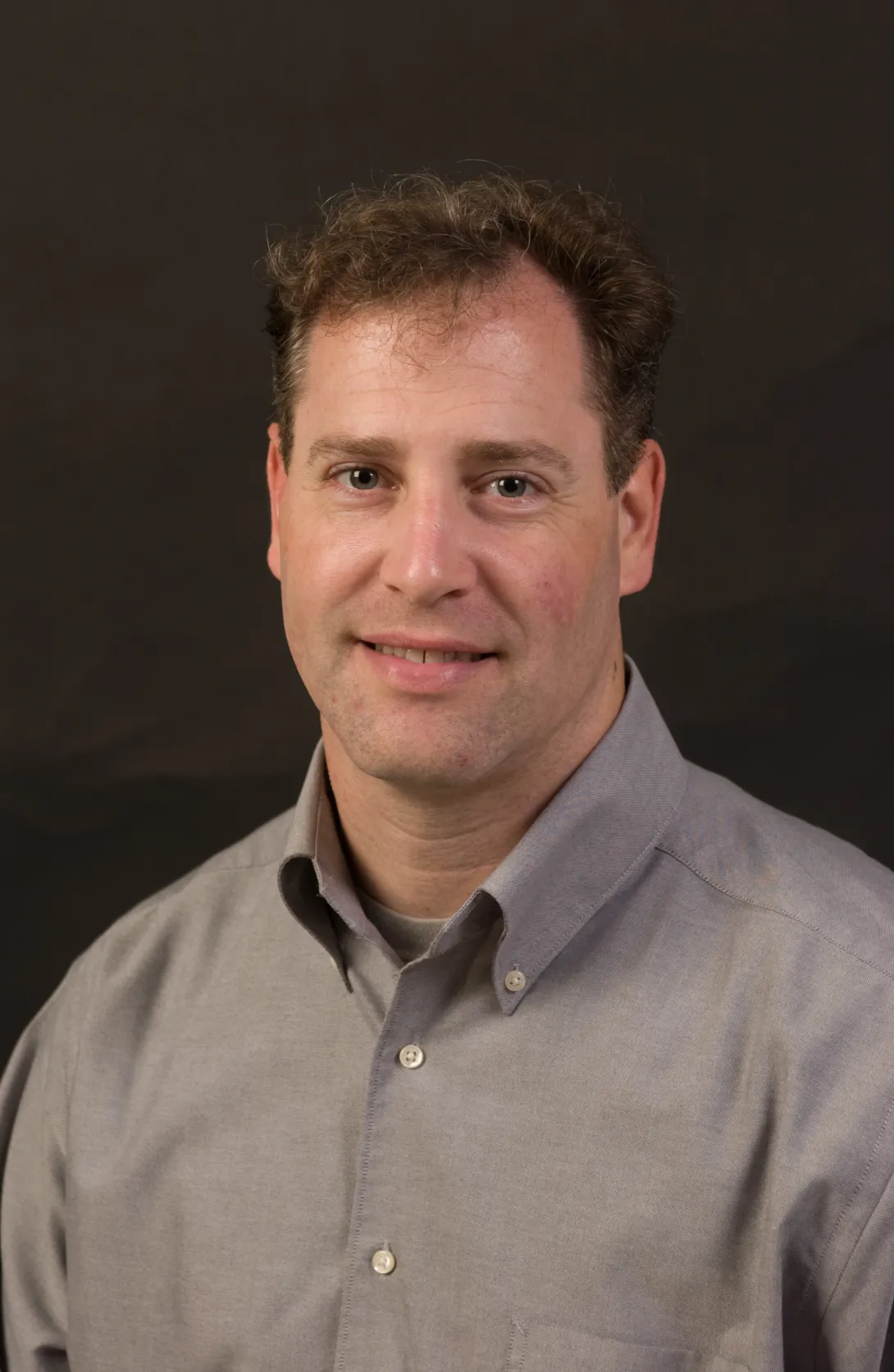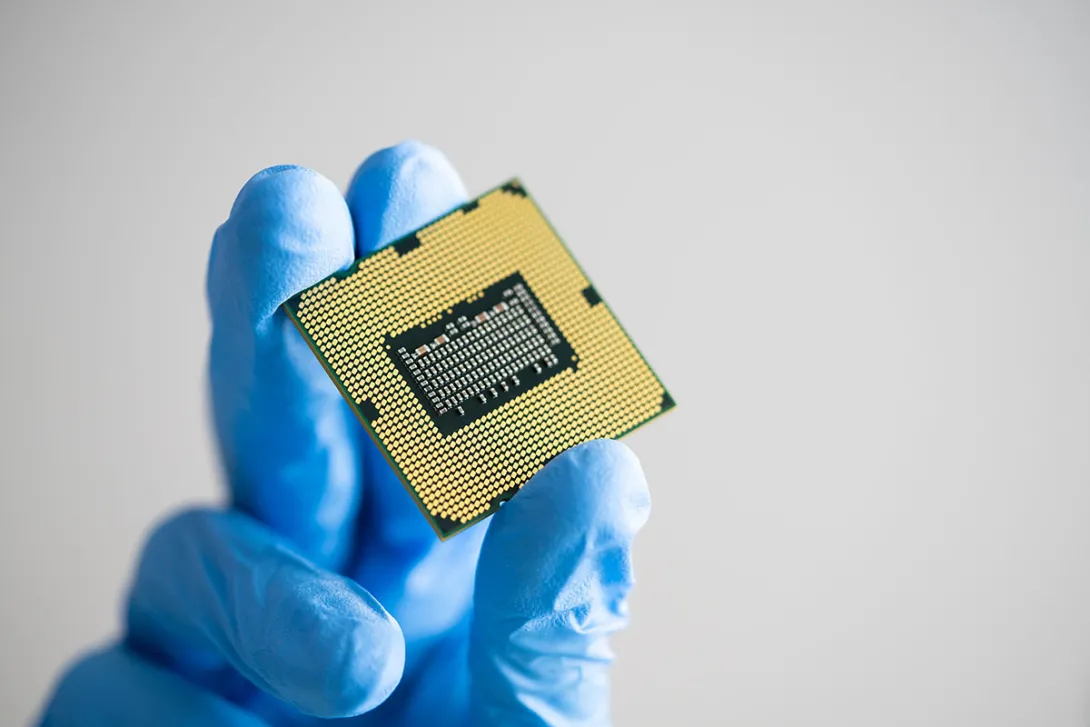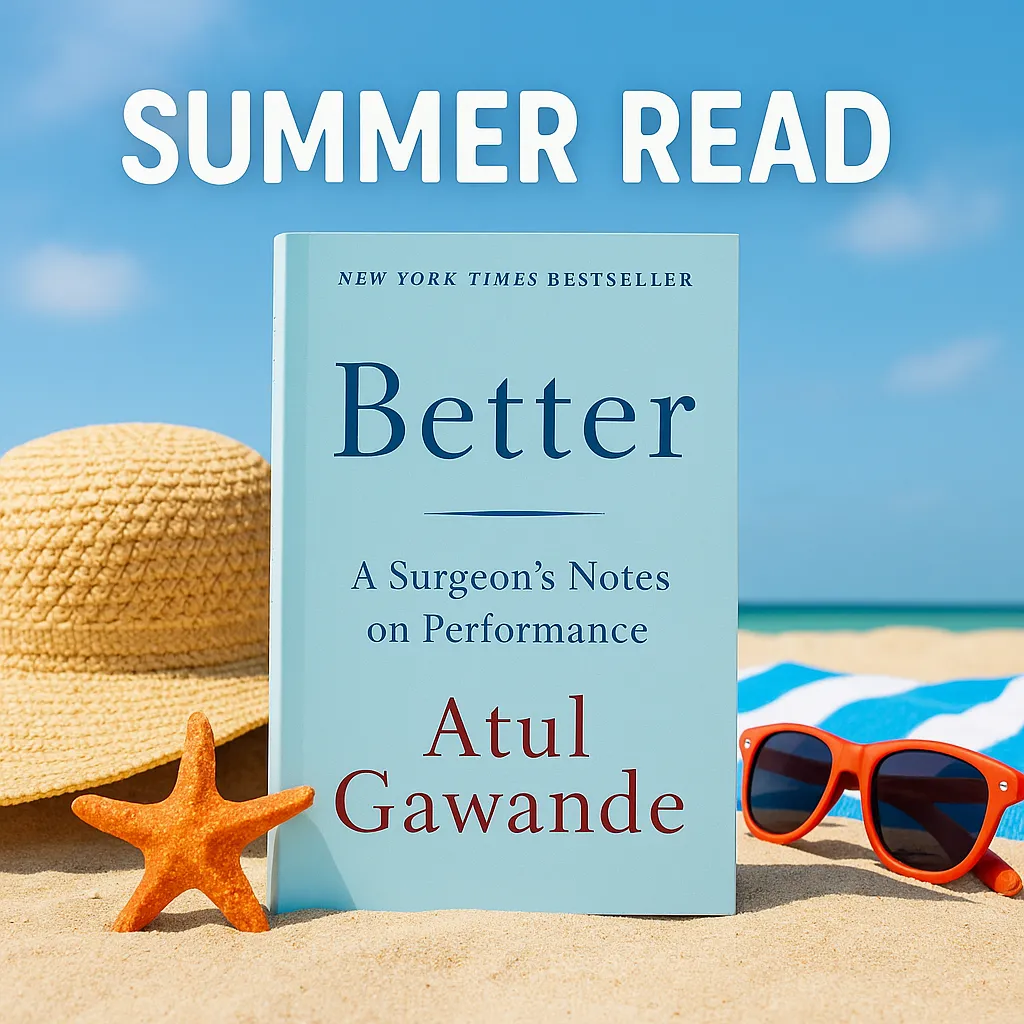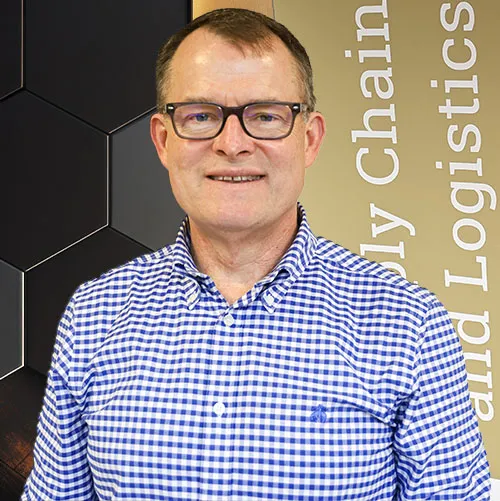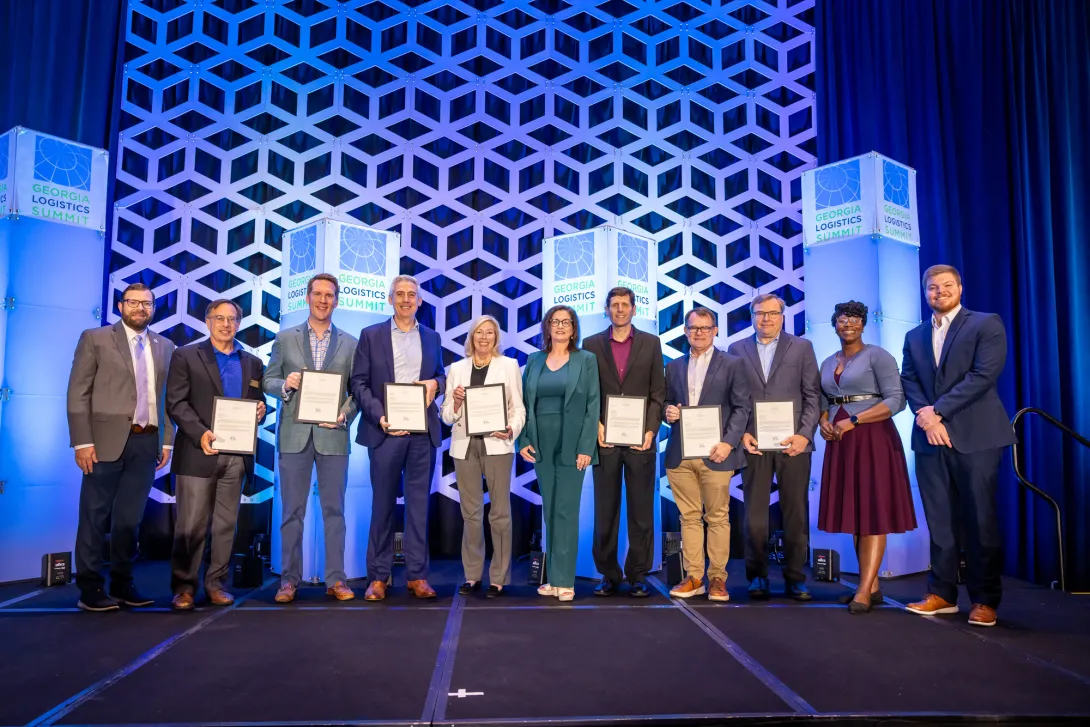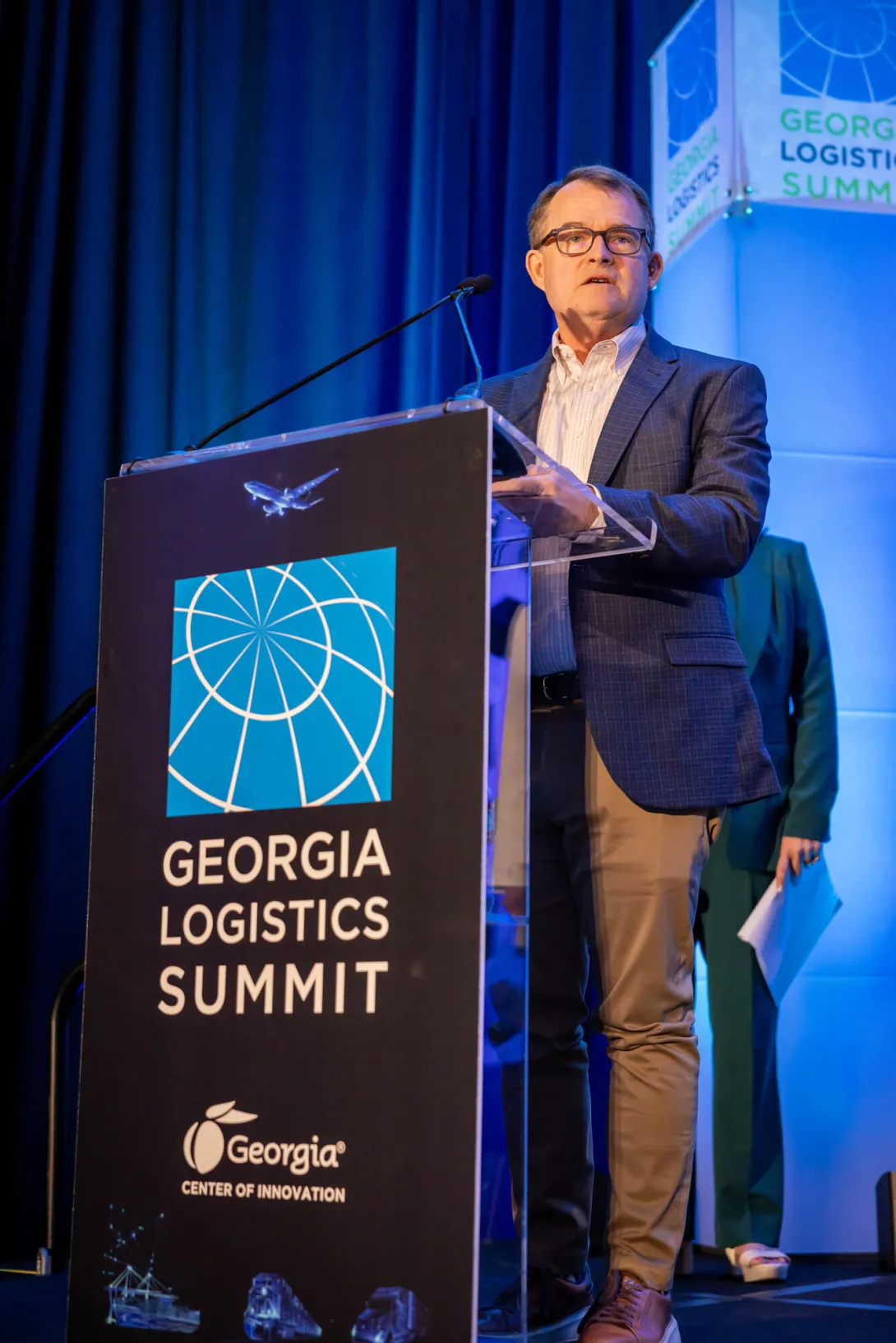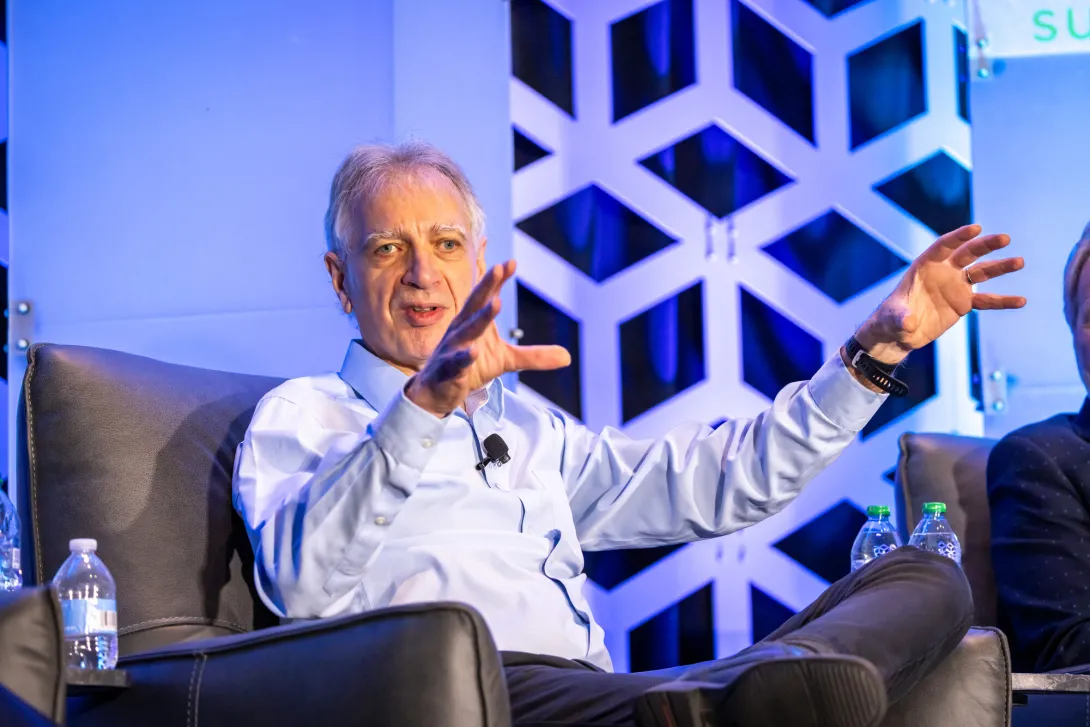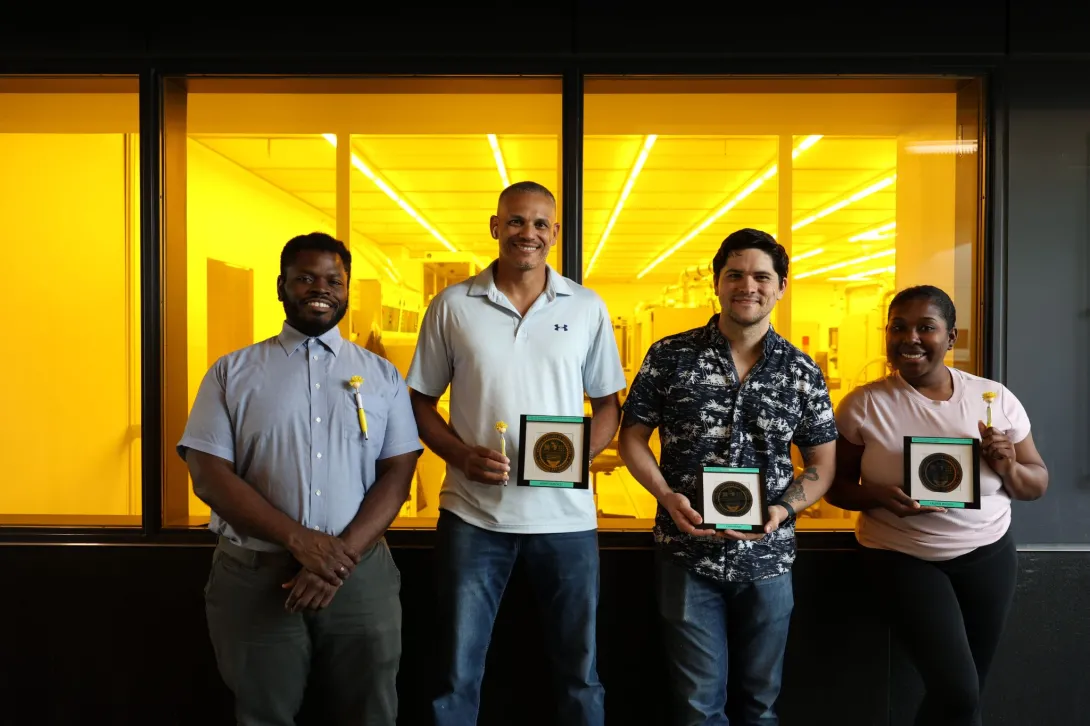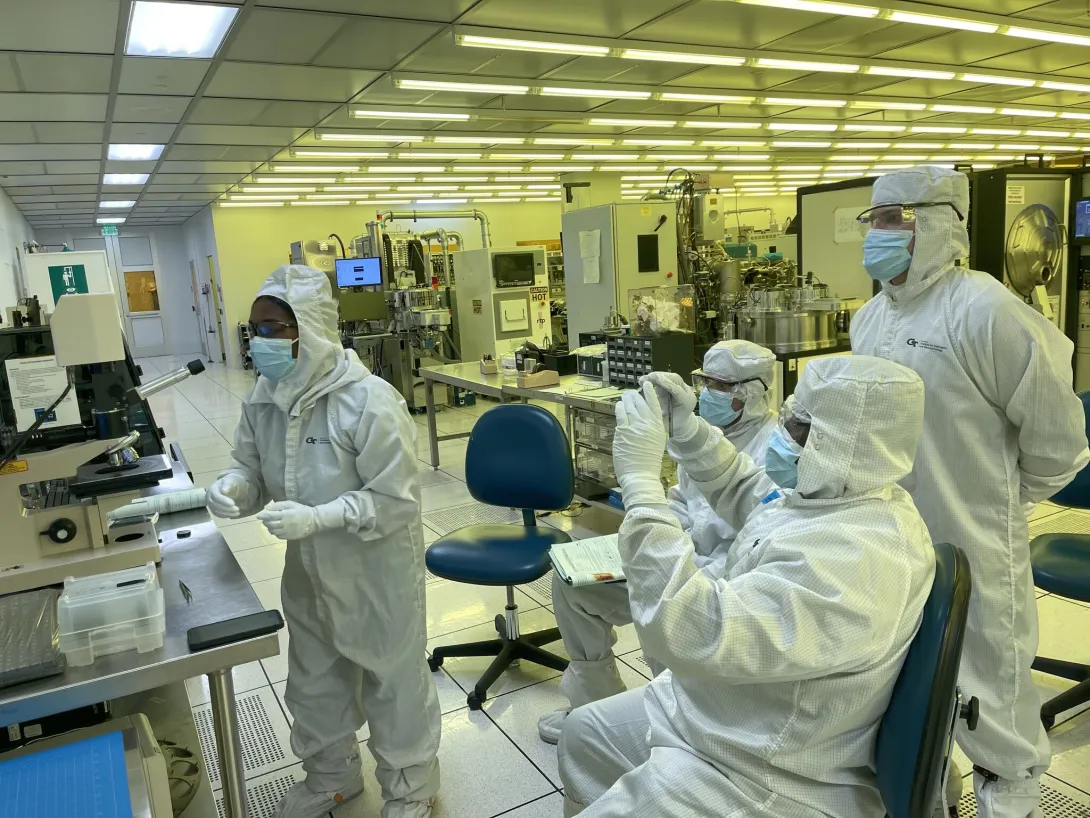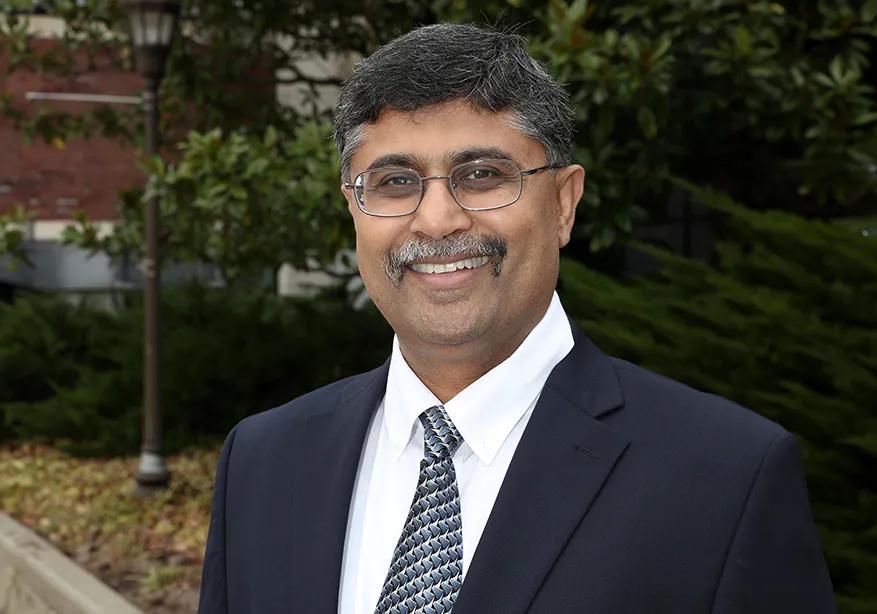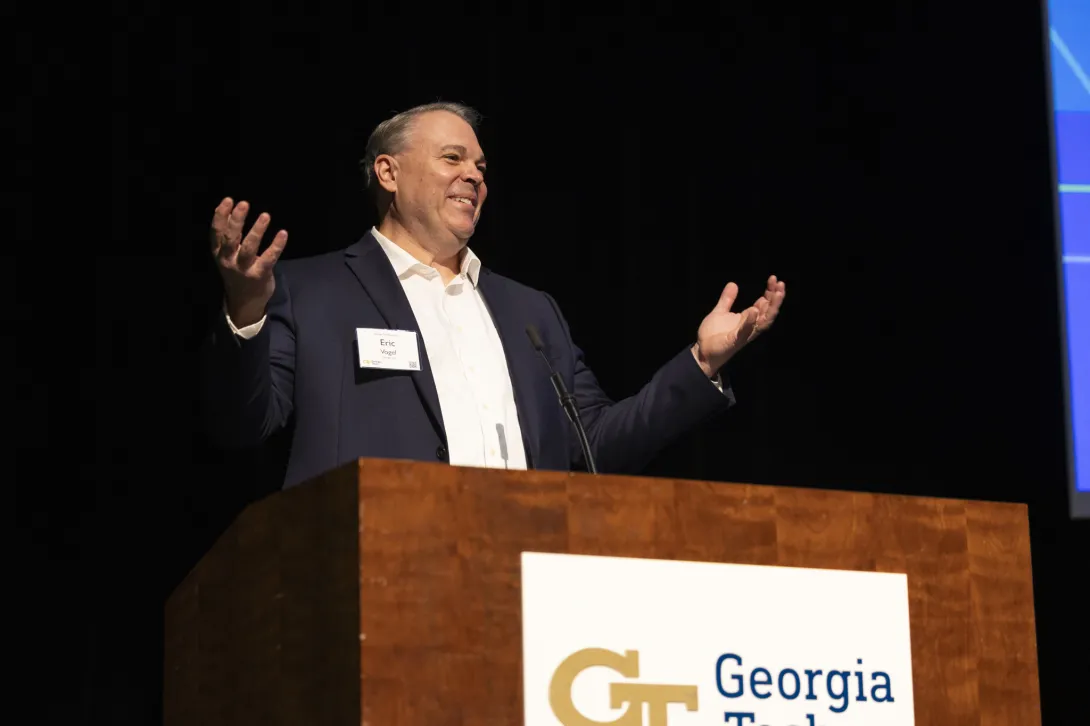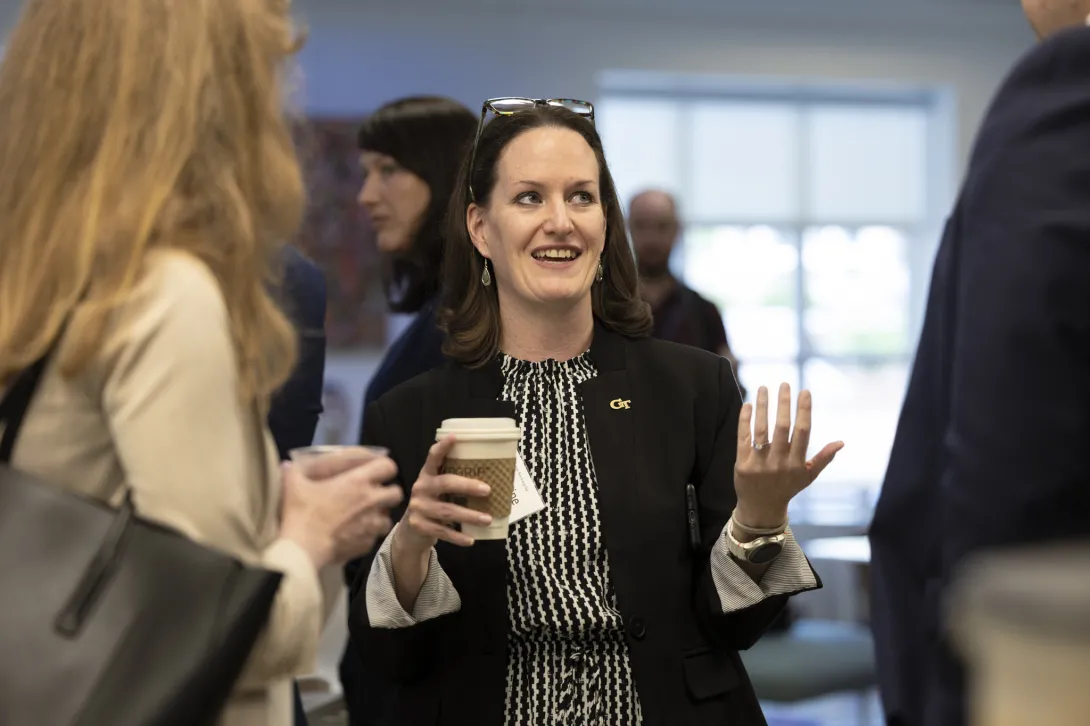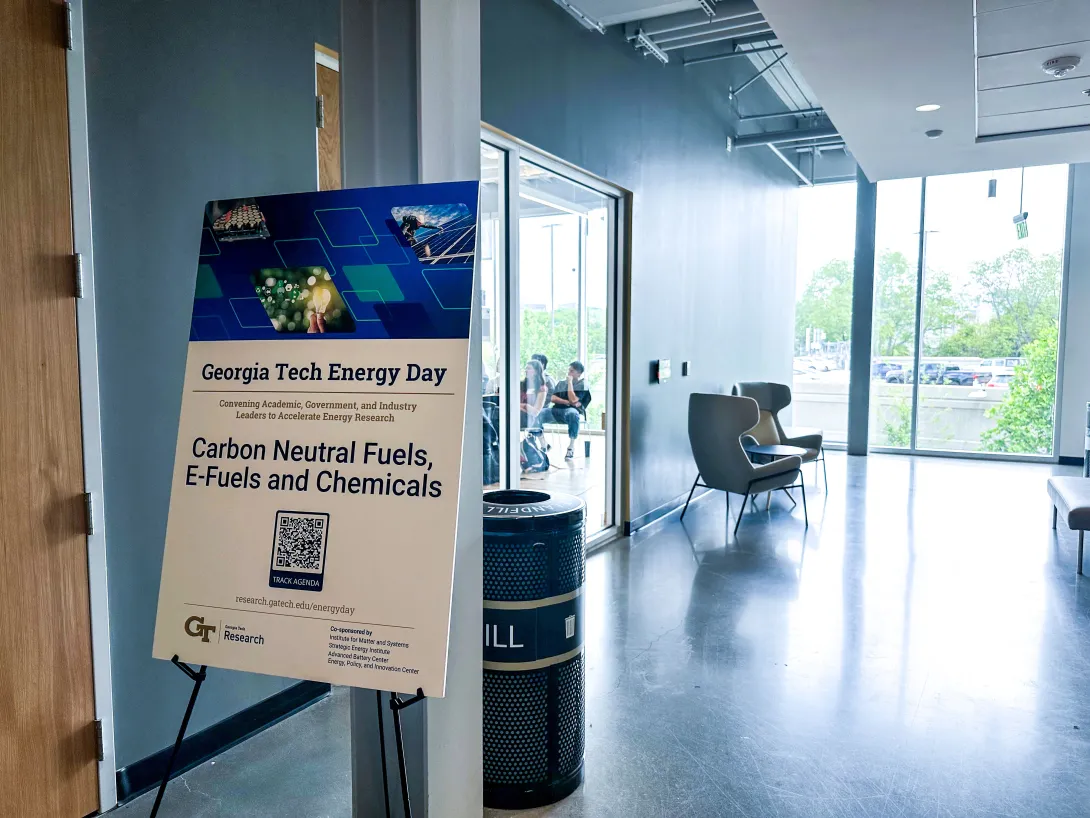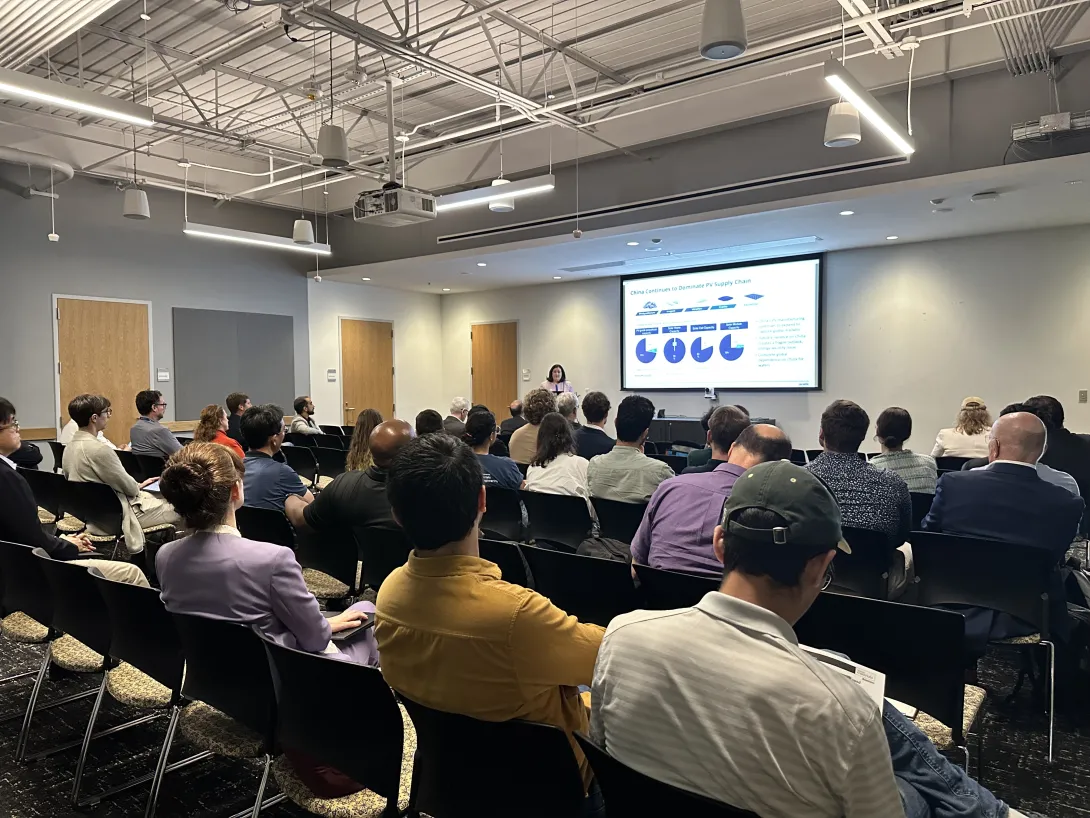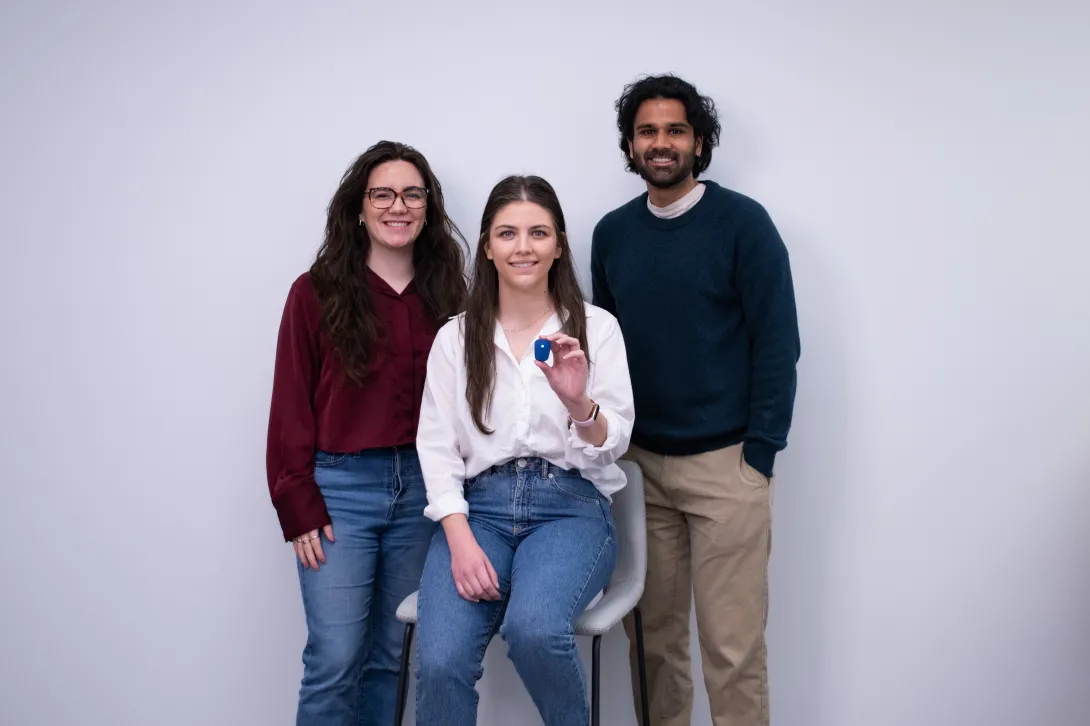May. 05, 2025
Imagine a future where robotic guide dogs lead the visually impaired, flying cars navigate the skies, and electric self-driving vehicles communicate effortlessly with pedestrians.
That future is being shaped today at Georgia Tech’s Center for Human-AI-Robot Teaming (CHART). Led by Bruce Walker, a professor in the School of Psychology and the School of Interactive Computing, the newly launched Center aims to transform how humans, artificial intelligence, and robots work together. By focusing on the dynamic partnership between humans and intelligent systems, CHART will explore how humans can collaborate more effectively with artificial intelligence systems and robots to solve critical scientific and societal challenges.
“There are wonderful Georgia Tech units like the Institute for People and Technology and the Institute for Robotics and Machines that do an incredible job focusing on using and creating intelligent systems and technology,” says Walker. “CHART adds value to this ecosystem with our emphasis on the interactive partnership between humans, AI technology, and robots and machines with agency.”
Based in the School of Psychology, CHART has built an international and interdisciplinary consortium of researchers and innovators from academia and industry. Its impressive membership includes researchers from five Georgia Tech colleges, 18 universities worldwide, industry, public policy organizations, cities, and NASA.
“With expertise encompassing psychology, design, interactive computing, robotics, aerospace engineering, mechanical engineering, public policy, and business, CHART leverages a wealth of knowledge to help us tackle multifaceted challenges — and we’re adding new members every week,” says Walker.
To help shepherd this growth, CHART’s Steering Committee includes School of Psychology Professor Christopher Wiese and Assistant Professor Mengyao Li and School of Mechanical Engineering Assistant Professor Ye Zhao.
Tomorrow’s technology
Several research programs already underway at CHART showcase its vision of deeply transformative, human-centered research:
Robotic guide dogs
Walker co-leads this research with Sehoon Ha, an assistant professor in the School of Interactive Computing. The project explores the partnership between a robotic guide dog robot and a human as they navigate the physical and social environment. Key concerns include trust, communication, sharing of responsibilities, and how the human-robot team integrates into social settings. The project also addresses practical design issues like ensuring the robot operates quietly to avoid interfering with auditory cues critical for blind users.
Flying cars
This project investigates how humans will interact with emerging flying vehicle technologies. It explores user interfaces, control systems, and human-machine interaction design, including whether traditional steering controls might evolve into joystick-like mechanisms. Broader issues include how flying cars will fit into current infrastructure, impacts on pilot licensing policy and regulation, and the psychology of adopting futuristic technologies.
Pedestrians and self-driving cars
Researchers are exploring how driverless electric vehicles and pedestrians can communicate to keep our future streets safe, including how vehicles signal their intentions to pedestrians. Teams are also implications for safety and public policy, including accident liability and the quiet nature of electric vehicles.
Generative AI in Education
This project examines how students use generative AI like ChatGPT as collaborators in learning. The research explores its effects on outcomes, education policy, and curriculum development.
Meet CHART Founding Director Bruce Walker
Walker is excited about CHART’s future and its role in improving the world.
“We’ve got an ambitious plan and with the caliber of researchers we have assembled from around the world, the possibilities are limitless,” says Walker. “I see Georgia Tech leading the way as a center of gravity in this space.”
His background renders him well-suited to the interdisciplinary nature of the Center. Walker brings a wealth of experience in psychology, human-computer interaction, and related fields, with research interests spanning sonification and auditory displays, trust in automation, technology adoption, human-AI-robot teaming, and assistive technologies. In addition to CHART, he's the director of the Georgia Tech Sonification Lab.
Walker’s academic research has resulted in more than 250 journal articles and proceedings, and he has consulted for NASA, state and federal governments, private companies, and the military. He is also an active entrepreneur, founding startups and working on projects related to COVID diagnosis, skin cancer detection, mental health monitoring, gun safety, and digital scent technology.
Reflecting on the journey ahead, Walker says, “We’ve come out of the gate strong. I look forward to the innovations ahead and continuing to cultivate a community of future leaders in this field.”
News Contact
Laura S. Smith, writer
May. 02, 2025
Jason Azoulay is an associate professor of Chemistry and Biochemistry and Materials Science and Engineering at Georgia Tech. He is the Georgia Research Alliance Vasser-Woolley Distinguished Investigator in Optoelectronics and serves as co-director of the Center for Organic Photonics and Electronics.
This story by Janette Neuwahl Tannen is shared jointly with the University of Miami newsroom.
Today, most of us carry a fairly powerful computer in our hand — a smartphone.
But computers weren’t always so portable. Since the 1980s, they have become smaller, lighter, and better equipped to store and process vast troves of data.
Yet the silicon chips that power computers can only get so small.
“Over the past 50 years, the number of transistors we can put on a chip has doubled every two years,” says Kun Wang, assistant professor of physics at the University of Miami College of Arts and Sciences. “But we are rapidly reaching the physical limits for silicon-based electronics, and it’s more challenging to miniaturize electronic components using the technologies we have been using for half a century.”
It’s a problem that Wang and many in his field of molecular electronics are hoping to solve. Specifically, they are looking for a way to conduct electricity without using silicon or metal, which are used to create computer chips today. Using tiny molecular materials for functional components, like transistors, sensors, and interconnects in electronic chips offers several advantages, especially as traditional silicon-based technologies approach their physical and performance limits.
But finding the ideal chemical makeup for this molecule has stumped scientists. Recently, Wang, along with his graduate students, Mehrdad Shiri and Shaocheng Shen, and collaborators Jason Azoulay, associate professor at Georgia Institute of Technology and Georgia Research Alliance Vasser-Woolley Distinguished Investigator; and Ignacio Franco, professor at the University of Rochester, uncovered a promising solution.
This week, the team shared what they believe is the world’s most electrically conductive organic molecule. Their discovery, published in the Journal of the American Chemical Society, opens up new possibilities for constructing smaller, more powerful computing devices at the molecular scale. Even better, the molecule is composed of chemical elements found in nature — mostly carbon, sulfur, and nitrogen.
“So far, there is no molecular material that allows electrons to go across it without significant loss of conductivity,” Wang says. “This work is the first demonstration that organic molecules can allow electrons to migrate across it without any energy loss over several tens of nanometers.”
The testing and validation of their unique new molecule took more than two years.
However, the work of this team reveals that their molecules are stable under everyday ambient conditions and offer the highest possible electrical conductance at unparalleled lengths. Therefore, it could pave the way for classical computing devices to become smaller, more energy-efficient, as well as cost-efficient, Wang adds.
Currently, the ability of a molecule to conduct electrons decreases exponentially as the molecular size increases. These newly developed molecular “wires” are needed highways for information to be transferred, processed, and stored in future computing, Wang says.
“What’s unique in our molecular system is that electrons travel across the molecule like a bullet without energy loss, so it is theoretically the most efficient way of electron transport in any material system,” Wang notes. “Not only can it downsize future electronic devices, but its structure could also enable functions that were not even possible with silicon-based materials.”
Wang means that the molecule’s abilities might create new opportunities to revolutionize molecule-based quantum information science.
“The ultra-high electrical conductance observed in our molecules is a result of an intriguing interaction of electron spins at the two ends of the molecule,” he adds. “In the future, one could use this molecular system as a qubit, which is a fundamental unit for quantum computing.”
The team was able to notice these abilities by studying their new molecule under a scanning tunneling microscope (STM). Using a technique called STM break-junction, the team was able to capture a single molecule and measure its conductance.
Shiri, the graduate student, adds: “In terms of application, this molecule is a big leap toward real-world applications. Since it is chemically robust and air-stable, it could even be integrated with existing nanoelectronic components in a chip and work as an electronic wire or interconnects between chips.”
Beyond that, the materials needed to compose the molecule are inexpensive, and it can be created in a lab.
“This molecular system functions in a way that is not possible with current, conventional materials,” Wang says. “These are new properties that would not add to the cost but could make (computing devices) more powerful and energy efficient.”
DOI: https://doi.org/10.1021/jacs.4c18150
Funding: U.S. Department of Energy, Office of Science, Basic Energy
Sciences; National Science Foundation (NSF); Air Force Office of Scientific Research (AFOSR) under support provided by the Organic Materials
Chemistry Program; Georgia Tech Research Institute (GTRI) Graduate
Student Researcher Fellowship Program (GSFP). Computational resources were provided by the Center for Integrated Research Computing (CIRC) at the
University of Rochester.
Along with Jason Azoulay, Georgia Tech co-authors also include Paramasivam Mahalingam, Tyler Bills, Alexander J. Bushnell, and Tanya A. Balandin.
News Contact
Jess Hunt-Ralston
Director of Communications
College of Sciences at Georgia Tech
May. 01, 2025
The Georgia Institute of Technology will receive up to $2 million to research advanced semiconductor packaging technologies. Georgia Tech was selected as a partner institution by the South Korean Ministry of Trade.
The Institute for Matter and Systems (IMS), George W. Woodruff School of Mechanical Engineering, and the 3D Systems Packaging Research Center (PRC) will work with Myongji University and industry partners in South Korea on a seven-year collaborative project that focuses on developing core evaluation technologies for advanced semiconductor packaging.
The project is led by Seung-Joon Paik, IMS research engineer; Yongwon Lee, research engineer in the George W. Woodruff School of Mechanical Engineering; and Kyong-Sik “Jack” Moon, PRC research engineer. It is funded by the Korea Planning & Evaluation Institute of Industrial Technology of the Ministry of Trade, Industry and Energy in Korea.
The project aims to develop validation technologies for next-generation 3D packaging with strategic globally competitive capabilities. The developed platform will meet the high growing demand for advanced packaging technologies for artificial intelligence, high-performance computing, and chiplet-based semiconductor. As a designated partner, Georgia Tech will play a pivotal role in developing core evaluation technologies.
The project’s outcomes will contribute to the commercialization of dependable packaging technologies and the resilience of the global semiconductor supply chain.
News Contact
Amelia Neumeister | Research Communications Program Manager
Apr. 30, 2025
In the world of supply chain management, we spend much of our time searching for ways to make things better — more reliable, more efficient, more resilient. It’s a pursuit that can feel endless because improvement rarely comes from one grand move; instead, it is found in hundreds of small, thoughtful actions over time.
That’s why I’m recommending a summer read that, while not a traditional supply chain book, speaks directly to this spirit of continuous improvement: Better by Atul Gawande.
Gawande, a practicing surgeon and bestselling author, focuses much of his writing on the challenges of delivering better outcomes in medicine. But as you read Better, it becomes clear that the insights he shares transcend healthcare. In fact, many of them connect deeply to the work we do in supply chain. Health care, after all, is a complex supply chain in itself — one that must manage the flow of goods (medicines, equipment) and services (diagnosis, surgery, therapy) under conditions of great uncertainty and high stakes.
Gawande’s work reminds us that the principles that drive improvement in medicine are the same ones that drive improvement in supply chains, manufacturing, transportation, and just about every field where people are trying to do things better every day.
Three Takeaways for Supply Chain Professionals
1. The Relentless Pursuit of Better is Everyone’s Job
One of Gawande’s central points is that better performance is not reserved for “geniuses” or “experts” alone. In medicine, small, consistent improvements — asking an extra question, double-checking a dosage, washing hands properly — save lives. The same is true in supply chain.
In our world, whether it’s taking a second look at an inventory replenishment setting or spending a few extra minutes mapping supplier risks, the incremental pursuit of better outcomes can mean the difference between success and failure. There’s no standing still. Better is a moving target, and everyone on the team has a role in aiming for it.
2. Systems Matter as Much as Skill
Gawande makes a strong case that even the most skilled individuals can fail if the systems around them are poorly designed. A world-class surgeon operating in a broken hospital supply chain still faces high risks of failure.
Supply chains work the same way. Even great people can’t overcome a bad process or poor system design for long. When we evaluate our operations, it’s important to look beyond individual performance and address the structural barriers that prevent consistent execution. Strong systems allow talent to flourish; weak systems exhaust it.
3. Always Ask One More Question
One of my favorite insights from Better is the idea that sometimes, the most powerful thing you can do is simply ask one more question.
Gawande shares examples where small moments of curiosity or concern — asking a patient one more question about their symptoms, or a nurse asking why a process was skipped — led to major improvements or saved lives.
In supply chain, asking one more question can reveal unseen risks, highlight hidden opportunities, and help avoid costly mistakes. When considering a new supplier, a logistics routing change, or a forecasting adjustment, taking the time to dig a little deeper often makes the difference between a smooth operation and a big problem.
As supply chain learners and leaders, developing the habit of curiosity — and the courage to ask that extra question — is one of the simplest and most powerful habits we can cultivate.
Why Better is a Worthwhile Summer Read
What makes Better a great summer read is not just the quality of Gawande’s storytelling, but how accessible and applicable his lessons are. You don’t have to be a doctor to appreciate the challenges he describes, and you don’t have to be in a hospital to face similar decisions about quality, safety, and improvement.
Supply chains, like healthcare systems, are messy, imperfect, and always evolving. Gawande’s stories are a reminder that we improve not by finding perfect solutions, but by persistently chasing better ones — day after day, decision after decision.
If you’re looking for a book that will inspire you to think a little differently about your work, challenge you to ask better questions, and recharge your commitment to doing things better — Better is a worthy addition to your summer reading list.
I hope you’ll find it as insightful and motivating as I did. And as you turn its pages, I encourage you to keep a simple question in mind: What’s one thing I could do a little better today?
News Contact
info@scl.gatech.edu
Apr. 29, 2025
The Georgia Center of Innovation, a strategic arm of the Georgia Department of Economic Development (GDEcD), hosted hundreds of attendees at the 2025 Georgia Logistics Summit, where experts offered insights on the intersection of technology and logistics, updates on infrastructure investments, and how the state is preparing the future workforce to support growth. Established in 2009 as the first state-led event of its kind, the Georgia Logistics Summit is one of the Southeast’s key logistics and supply chain events, connecting industry professionals for networking and knowledge-sharing.
The economic impact of Georgia’s transportation and logistics industry was $107 billion in 2023, according to an economic impact study by the University of Georgia’s Selig Center for Economic Growth. These industries supported more than 578,000 Georgia jobs, or one in nine jobs in the state. From 2010 to 2023, transportation and logistics jobs in Georgia grew by 68%, outpacing the national growth rate of 52%. Additionally, in 2023 and 2024 alone, new logistics and distribution sector investments, including cold storage and ecommerce fulfillment centers, totaled $3.8 billion and created over 9,000 new jobs.
“Georgia’s unmatched global connectivity is one of the driving forces behind our economic success. Decades of strategic investment in our logistics and supply chain infrastructure – from our ports and rail lines to our highways and air cargo capabilities – have led to record-breaking economic investments and trade,” said Georgia Department of Economic Development Commissioner Pat Wilson. “The Logistics Summit brings together private sector, government, and education leaders to learn from experts, exchange best practices, and explore opportunities in the rapidly evolving logistics landscape to maximize opportunities. Events like this strengthen collaboration and spark new ideas that keep Georgia businesses competitive on a global scale.”
Georgia Department of Transportation Commissioner Russell R. McMurry highlighted Georgia’s strategic investments and how the Georgia Department of Transportation (GDOT) is leveraging technology to improve freight flow. He cited the leadership of Governor Brian P. Kemp and support from the General Assembly to allocate $1 billion to the newly created Georgia Freight Program over the past two years. Additional investments in transportation infrastructure are advancing the timing for key planned transportation projects that will maintain and improve Georgia’s interstate highway system, roads, and bridges. Georgia’s multimodal transportation network carried nearly half a billion tons of freight in 2019, valued at $673 trillion. Projections show that freight volume is expected to nearly double to 900 million in tonnage and freight value to more than double today’s value by 2050. Working with partners that include the Center of Innovation and the Georgia Institute of Technology, GDOT is focusing on enhancing safety and efficiency, including projects to add 50% more truck parking and installing fiber internet on Georgia interstates.
Georgia Ports Authority Vice President of Operations Susan Gardner provided updates on strategic investments to expand capacity at the ports, and how Georgia Ports Authority (GPA) is leveraging live data to improve safety, track vessel productivity and containers, and eliminate congestion. Gardner emphasized building a technological culture and prioritizing hiring creative employees, as well as harnessing data insights to boost efficiency. GPA is investing in $4.5 billion in improvements over the next decade as part of its port master plan to expand cargo handling capabilities and support future supply chain requirements.
This year’s feature panel, “AI and Beyond: Embracing Digital Transformation in Logistics,” included leadership from The Home Depot, Havertys Furniture, and TOTO USA, as well as research perspectives from the Georgia Institute of Technology. Panelists highlighted the ways digital technologies are reshaping supply chains, including a three- to five-year outlook for the industry, and provided insights attendees can use to shape their strategies to move more efficiently as AI and automation transform the industry.
“Digital technologies are reshaping supply chains in various ways, and Georgia is working to stay ahead of the curve,” said Center of Innovation Executive Director David Nuckolls. “The Center of Innovation and our specialized logistics team work alongside this dynamic industry, helping to position businesses for growth. The annual Georgia Logistics Summit is a powerful opportunity to build connections and equip businesses with crucial knowledge and resources.”
Educating the needed talent was the focus of the event’s final panel, with University System of Georgia Chancellor Sonny Perdue and Technical College System of Georgia Commissioner Greg Dozier providing updates on how the state’s post-secondary institutions are developing a globally competitive workforce. Discussion focused on how these institutions are ensuring the skills they are teaching match the jobs logistics companies are looking for, including creative problem-solving and effective use of new AI and automation tools. The breadth of Georgia’s technical college programs was also discussed, including the High Demand Career Initiatives program and a pilot program called “Dual Achievement” that enrolls students who withdrew from high school in a technical college program, enabling them to earn a high school diploma alongside a technical college certificate, diploma, or degree. Panelists focused on the importance of helping students get where they want to go faster, upskilling the existing workforce, and how connections between industry leaders and educators can help foster greater outcomes.
The Center of Innovation’s Logistics Industry Advisory Board also recognized the winners of the inaugural Future Innovators in Supply Chain competition. The competition invited college students to create videos about supply chain careers, reflecting the Center’s commitment to developing future logistics leaders. Led by professor Parisa Pooyan, student team “The Masters of Logistinomics” from Kennesaw State University won first prize and a $3,000 grant for the university. Eli Hampton, Angeline Harris, Joe Johnson, and Dana Pazhouhesh created the winning video, which can be viewed here.
For additional information on the 2025 Georgia Logistics Summit and to stay up-to-date on next year’s plans, visit galogisticssummit.com.
Participants in the 2025 Georgia Logistics Summit also included leaders from S&P Global Market Intelligence, Boost Phase Ventures, and M.D. Livingstone Consulting.
About the Georgia Center of Innovation
Exclusive to Georgia, the Center of Innovation helps Georgia businesses of all types and sizes find inspired solutions to challenges and opportunities. The Center connects new and expanding businesses with a team of experts, external partners, and independent mentors to tap into the technical expertise and guidance they need. By encouraging collaboration across six key industries: Aerospace, AgTech, Energy Technology, Information Technology, Logistics, and Manufacturing, the Center helps Georgia prepare for growth in strategic industry ecosystems.
About GDEcD
The Georgia Department of Economic Development (GDEcD) is the state’s sales and marketing arm. It is Georgia’s lead agency for attracting new business investment, encouraging the expansion of existing industry and small businesses, and locating new markets for Georgia products. As the state’s official destination marketing organization, it drives traveler visitation and promotes the state as a location for film and digital entertainment projects. GDEcD is responsible for planning and mobilizing state resources for economic development, fostering innovation and the arts to drive opportunity from the mountains to the coast.
News Contact
Allie Dean, Communications Manager, Georgia Department of Economic Development | adean@georgia.org
Apr. 29, 2025
The most recent cohort of the Microelectronics and Nanomanufacturing Certificate Program (MNCP) have completed their training and are ready to dive into the workforce.
The MNCP is a National Science Foundation (NSF) funded collaboration between the Institute for Matter and Systems (IMS), Georgia Piedmont Technical College (GPTC) and Pennsylvania State University’s Center for Nanotechnology Education and Utilization.
The spring 2025 cohort was comprised of three individuals with non-technical backgrounds. For 12 weeks, they split time between online lectures and hands-on training in the Georgia Tech Fabrication Cleanroom where they immersed themselves in advanced microelectronic fabrication techniques. Their training included thin film deposition, photolithography, etching, metrology, laser micro-machining, and additive manufacturing. They gained hands-on experience with industry-standard equipment, even creating their own custom designs on 4-inch silicon wafers.
“The program really helps people get their head start, especially for those who don’t really have the educational background,” said Lauren Walker, one student from the cohort. Walker applied for the program after hearing about it from a colleague and was able to get a job as a laboratory technician with help from the program resources.
“[The program] gave me everything I needed to know for new skills and things like that for the industry,” said Walker. “It helped me eventually get another job. I say it helped because of the workshops they had.”
Under the direction of Seung-Joon Paik, IMS teaching lab coordinator, the cohort spent two days a week in the IMS cleanroom working on research projects with IMS staff. Michelle Wu, a research scientist in IMS, served as lab instructor throughout the program and oversaw the training on cleanroom tools.
“As their lab instructor, I’ve been thoroughly impressed with their passion, patience, and unwavering dedication to this program,” said Wu.
The program is supported by the Advanced Technological Education program at the National Science Foundation and is free for all participants.
Learn more about the Microelectronics and Nanomanufacturing Certificate Program
News Contact
Amelia Neumeister | Research Communications Program Manager
Apr. 28, 2025
Shreyes Melkote, the Morris M. Bryan, Jr. Professor for Advanced Manufacturing Systems, will serve as interim chair of the George W. Woodruff School of Mechanical Engineering beginning May 15.
He will assume the temporary role after Devesh Ranjan departs Georgia Tech to become dean of the College of Engineering at the University of Wisconsin-Madison.
“I am deeply appreciative of Shreyes’ willingness to step into this role during our search process," said Raheem Beyah, dean of the College of Engineering and Southern Company Chair. "This appointment reflects his exceptional leadership on campus. Shreyes’ achievements and dedication to Georgia Tech make him the ideal person to guide us through this transition period, and I look forward to continuing our collaboration in this new capacity."
Melkote has been a Woodruff School faculty member since in 1995. His research focuses on subtractive and hybrid manufacturing, industrial robotics for manufacturing, and application of artificial intelligence and machine learning methods for automated manufacturing process planning.
He was awarded Georgia Tech’s outstanding achievement in research engagement and outreach award in 2024. The annual honor is presented by the Office of the Executive Vice President for Research.
Melkote is the associate director for the Georgia Tech Manufacturing Institute (GTMI), Georgia Tech's interdisciplinary research institute tackling the challenges facing manufacturers and helping to insure future global competitiveness. He also serves as executive director of the Novelis Innovation Hub.
“I am honored to serve the Woodruff School in an interim capacity. It is an opportunity to give back to the School and the Institute that have supported me in my professional growth during the past 30 years,” Melkote said. “I look forward to working with faculty, staff, and students until the next school chair is chosen to lead it.”
Melkote has published nearly 300 peer-reviewed papers in leading journals and conference proceedings. His honors include the American Society of Mechanical Engineers’ (ASME) Milton C. Shaw Manufacturing Research Medal and the Blackall Machine Tool and Gage Award. He also was awarded the Society of Manufacturing Engineer’s (SME) Gold Medal and Dell K. Allen Outstanding Young Manufacturing Engineer Award.
Melkote is an elected Fellow of ASME, SME, and CIRP, The International Academy for Production Engineering.
News Contact
Jason Maderer (maderer@gatech.edu)
Apr. 28, 2025
More than 300 people from industry, government, and academia converged on Georgia Tech’s campus for Energy Day. They gathered for discussion and collaboration on the topics of energy storage, solar energy conversion, and developments in carbon-neutral fuels.
Taking place on April 23, Energy Day was cohosted by Georgia Tech’s Institute for Matter and Systems (IMS), Strategic Energy Institute (SEI), the Georgia Tech Advanced Battery Center, and the Energy Policy and Innovation Center.
“The ideas coming out of Georgia Tech and other research universities can drive greater partnerships with our local and state officials. Whether you live in Georgia or elsewhere, we are changing how energy is viewed and consumed,” said Tim Lieuwen, Georgia Tech executive vice president for Research.
Energy Day 2025 is the latest evolution in a series of events that began as in 2023 Battery Day. As local and national energy research needs have evolved, the event has grown to highlight Georgia Tech, and the state of Georgia, as a go-to location for modern energy companies.
“At Georgia Tech, we approach energy holistically, leveraging innovative R&D, economic policy, community-building and strategic partnerships,” said Christine Conwell, SEI's interim executive director. “We are thrilled to convene this event for the third year. The keynote and sessions highlight our comprehensive strategy, showcasing cutting-edge advancements and collaborative efforts driving the next big energy innovations."
The day was divided into two parts: a morning session that included a keynote speaker and two panels, and an afternoon session with separate tracks addressing three different energy research areas. Speakers shared research being conducted at Georgia Tech, as well as updates from industry leaders, to create an open dialogue about current energy needs.
“We believe we can solve problems and build the economy when you bring various disciplines together and work from matter — the fundamental scientists and devices all the way out to final systems at large — economic systems, societal systems,” said Eric Vogel, executive director for IMS. “Not only did we share the latest research, but we discussed and debated how we can continue to transform the energy economy.”
Discussions ranged from adapting to rapid changes in battery storage to advancing photo-voltaic manufacturing in the U.S. to the environmental impacts and sustainable practices of e-fuels and renewable energy.
The day ended with a robust poster session that attracted more than 25 student posters presentations. Three were awarded best posters.
First place: Austin Shoemaker
Second Place: Roahan Zhang
Third Place: Connor Davel
Related Links:
Advancing Clean Energy: Georgia Tech Hosts Energy Materials Day
Georgia Tech Battery Day Reveals Opportunities in Energy Storage Research
News Contact
Amelia Neumeister | Research Communications Program Manager
Apr. 28, 2025
Origami — the Japanese art of folding paper — could be at the next frontier in innovative materials.
Practiced in Japan since the early 1600s, origami involves combining simple folding techniques to create intricate designs. Now, Georgia Tech researchers are leveraging the technique as the foundation for next-generation materials that can both act as a solid and predictably deform, “folding” under the right forces. The research could lead to innovations in everything from heart stents to airplane wings and running shoes.
Recently published in Nature Communications, the study, “Coarse-grained fundamental forms for characterizing isometries of trapezoid-based origami metamaterials,” was led by first author James McInerney, who is now a NRC Research Associate at the Air Force Research Laboratory. McInerney, who completed the research while a postdoctoral student at the University of Michigan, was previously a doctoral student at Georgia Tech in the group of study co-author Zeb Rocklin. The team also includes Glaucio Paulino (Princeton University), Xiaoming Mao (University of Michigan), and Diego Misseroni (University of Trento).
“Origami has received a lot of attention over the past decade due to its ability to deploy or transform structures,” McInerney says. “Our team wondered how different types of folds could be used to control how a material deforms when different forces and pressures are applied to it” — like a creased piece of cardboard folding more predictably than one that might crumple without any creases.
The applications of that type of control are vast. “There are a variety of scenarios ranging from the design of buildings, aircraft, and naval vessels to the packaging and shipping of goods where there tends to be a trade-off between enhancing the load-bearing capabilities and increasing the total weight,” McInerney explains. “Our end goal is to enhance load-bearing designs by adding origami-inspired creases — without adding weight.”
The challenge, Rocklin adds, is using physics to find a way to predictably model what creases to use and when to achieve the best results.
Deformable solids
Rocklin, a theoretical physicist and associate professor in the School of Physics at Georgia Tech, emphasizes the complex nature of these types of materials. “If I tug on either end of a sheet of paper, it's solid — it doesn’t separate,” he explains. “But it's also flexible — it can crumple and wave depending on how I move it. That’s a very different behavior than what we might see in a conventional solid, and a very useful one.”
But while flexible solids are uniquely useful, they are also very hard to characterize, he says. “With these materials, it is often difficult to predict what is going to happen — how the material will deform under pressure because they can deform in many different ways. Conventional physics techniques can't solve this type of problem, which is why we're still coming up with new ways to characterize structures in the 21st century.”
When considering origami-inspired materials, physicists start with a flat sheet that's carefully creased to create a specific three-dimensional shape; these folds determine how the material behaves. But the method is limited: only parallelogram-based origami folding, which uses shapes like squares and rectangles, had previously been modeled, allowing for limited types of deformation.
“Our goal was to expand on this research to include trapezoid faces,” McInerney says. Parallelograms have two sets of parallel sides, but trapezoids only need to have one set of parallel sides. Introducing these more variable shapes makes this type of creasing more difficult to model, but potentially more versatile.
Breathing and shearing
“From our models and physical tests, we found that trapezoid faces have an entirely different class of responses,” McInerney shares. In other words — using trapezoids leads to new behavior.
The designs had the ability to change their shape in two distinct ways: "breathing" by expanding and contracting evenly, and “shearing" by deforming in a twisting motion. “We learned that we can use trapezoid faces in origami to constrain the system from bending in certain directions, which provides different functionality than parallelogram faces,” McInerney adds.
Surprisingly, the team also found that some of the behavior in parallelogram-based origami carried over to their trapezoidal origami, hinting at some features that might be universal across designs.
“While our research is theoretical, these insights could give us more opportunities for how we might deploy these structures and use them,” Rocklin shares.
Future folding
“We still have a lot of work to do,” McInerney says, sharing that there are two separate avenues of research to pursue. “The first is moving from trapezoids to more general quadrilateral faces, and trying to develop an effective model of the material behavior — similar to the way this study moved from parallelograms to trapezoids.” Those new models could help predict how creased materials might deform under different circumstances, and help researchers compare those results to sheets without any creases at all. “This will essentially let us assess the improvement our designs provide,” he explains.
“The second avenue is to start thinking deeply about how our designs might integrate into a real system,” McInerney continues. “That requires understanding where our models start to break down, whether it is due to the loading conditions or the fabrication process, as well as establishing effective manufacturing and testing protocols.”
“It’s a very challenging problem, but biology and nature are full of smart solids — including our own bodies — that deform in specific, useful ways when needed,” Rocklin says. “That’s what we’re trying to replicate with origami.”
This research was funded by the Office of Naval Research, European Union, Army Research Office, and National Science Foundation.
Apr. 25, 2025
According to the National Institutes of Health, nearly one-fourth of the U.S. population over age 45 suffers from foot and ankle issues, which reduce their quality of life, adversely affect walking and other daily functions, and increase the risk of falls.
For orthopedic patients recovering from surgery, walking properly can speed recovery, enabling them to more quickly regain mobility and quality of life. Walking issues or problems with one’s gait can also indicate larger medical problems, from vascular disease to brain, nerve, or spinal cord injuries.
Three alumni from Georgia Tech’s School of Electrical and Computer Engineering and School of Bioengineering hope to help doctors and patients analyze walking patterns through their wearable sensor startup, StrideLink.
“In the same way a cardiologist puts an EKG on you to monitor your heart, we essentially have designed that for walking ability,” says StrideLink founder and CEO Marzeah “Zea” Khorramabadi.
Initially targeting orthopedic practices for their platform, the HIPAA-compliant system wirelessly analyzes patients’ gaits to help doctors remotely monitor their walking ability before and after surgery to better address issues and provide more personalized treatment.
The 26-year-old Georgia Tech graduate of computer engineering founded StrideLink in 2021 with two other Tech students: Cassandra McIltrot, a 2022 biomedical and medical engineering graduate, and Neel Narvekar, who completed his computer engineering studies in 2021.
Since starting StrideLink, the three have raised just under $1 million in pre-seed funding and are now starting their Series A funding push.
McIltrot, 24, serves as research director at StrideLink. She says talking to surgeons, physical therapists, and patients was invaluable in building the StrideLink platform, which includes a physical sensor that connects via Bluetooth to a mobile platform. Orthopedic physicians can then access a secure interface to view their patients’ gait data.
“Being able to learn from all those people helped us build something that will bring value,” she says.
Narvekar, the startup’s CTO, calls the technology “a game-changer,” noting, “For the first time, we can widely collect clinically relevant gait data. Starting in orthopedics, this means we can build datasets to predict recovery timelines, identify when patients are off track, and intervene before adverse events occur. Ultimately, this will pave the way for improved care across a range of health conditions."
The enterprising entrepreneurs didn’t do it alone. They leveraged CREATE-X, which supports students in launching successful startups through education, coaching, funding, and other resources.
Below, Khorramabadi and McIltrot share more about their journey as members of the first cohort of CREATE-X’s Female Founders program in Fall 2020. In Summer 2021, the duo completed Startup Launch, a 12-week summer accelerator that helps students launch startups.
Did you two always want to start your own business?
Khorramabadi: It was kind of inevitable for Cassie and me. My dad immigrated from Iran and met my mom here. He started his own business selling cars. So, I grew up with a family that was running a small business. I’ve always had that in me, and it was the expectation that I would go to college. I picked Georgia Tech specifically because they had showcased the CREATE-X program during the tour.
McIltrot: My dad had a construction consulting business, and my mom was a nurse. That’s where the medical influence came from for me. He’s also an engineer. The summer that we decided to pursue this, I was doing research on stroke rehab at Emory.
How did you come up with your big idea?
Khorramabadi: In the middle of the pandemic, there was a lot of emphasis on technology — leaving the clinic and being in a patient's home. How are we going to deliver healthcare effectively when patients aren't directly in front of their doctor?
At the same time, Cassie was doing stroke research, and there was a lot around how heavily walking ability, walking patterns, or your gait is affected. We talked to healthcare professionals, physical therapists, surgeons, everyone. And it was clear that there was a pretty big gap in the market in terms of the technology that would serve these patients who have any symptoms that show up in their walking ability. It wasn’t measured at all. So, we ended up landing on a gait monitor as a solution.
We realized there was a very immediate, straightforward need for our product in orthopedics. If you're getting a knee replacement, ankle, or foot surgery, it's valuable to be able to put this product on a patient preoperatively to better prepare them for surgery. Surgeons can take real measurements of what their patients’ walking ability looks like before surgery and then track them throughout the entirety of their post-op recovery, which can be three months, six months, or even 12 months.
How does the solution work?
Khorramabadi: We designed our platform from the ground up. Our physical sensor connects to a mobile application. That mobile application connects to an entire cloud architecture that has processing servers and database storage. On the physician side, we have an interface for them to view data that fits into their workflow, including receiving insurance reimbursement. The technology component was designed in-house by Neil and me, given our backgrounds in computer engineering.
Are you using AI or advanced analytics in your platform?
Khorramabadi: We have a lot of very advanced data processing methods that are entirely proprietary to our system. We’ve acquired enough data from all of the patients we've seen with Emory, and now we're tracking patients remotely, where we are starting to use real clinical data to train AI to deliver a performance score to these patients. It’s essentially one number that rates how you’re doing related to a healthy or normal gait. We're already using AI right now, and that's something that's going to be released with our product within the next six months.
Where are you in terms of product maturity?
Khorramabadi: We recently started with our first fully remote full-time customer. Before that, we were doing research with another physician at Emory, where they had used it for over a year. At this point, they've tracked over 250 patients, where they put the sensors on at their pre-op appointment and then track them during post-op follow-ups.
They weren’t sent home with the sensors until our sensor was FDA-listed last year, and then we started our first pilot with a private practice in Amelia Island, Florida, last October. That has gone incredibly well, so we just expanded to an orthopedic practice in Alabama, and we should be getting two more practices started in 2025. We've solidified the product fit, and we’re now at the point of scaling it. We also have a research partnership with Children's Hospital Colorado to work on a pediatrics application.
What was most helpful about the CREATE-X programs you participated in at Georgia Tech?
Khorramabadi: Georgia Tech makes exploring doing a startup easy and low-risk for any student. The fact that it was so accessible was monumental early on. In terms of programming, the most valuable part was the emphasis on customer discovery. They did a good job, saying, “You don't know what to build until you talk to enough customers.”
We needed a mentor as part of our first startup class, and we read how James Stubbs, a tenured professor in biomedical engineering, was a previous founder. He’d done a couple of medical device companies that had been acquired. At our first meeting, he told us we need to talk to people. From a business standpoint, it made more sense for us to go to orthopedics rather than physical therapy for a whole host of reasons. But the biggest takeaway of talking to customers was a very consistent experience with both the Startup Launch and the Female Founders program.
McIltrot: The Female Founders program did a fantastic job of that, where we set goals as teams and were encouraged to talk to as many people we think are going to be our customers. We then met as a group and presented what we learned.
So you have to get out of get out of your comfort zone, and not be shy about engaging with people. Cassie, what was the big benefit for you?
McIltrot: We were the first cohort for Female Founders. We checked in every week with our team. Everyone would talk about what they learned that week while talking to people. We were the only medical-focused startup in the program, but being able to share the experience of how we approached people allowed us to learn from each other. We like keeping up with each other on LinkedIn. We learned one of the people in our cohort just closed a funding round.
Is having a community of other women entrepreneurs helpful?
Khorramabadi: Definitely. We’ve gotten a lot out of building a network, especially coming from starting this out of college, where you don't have any industry connections built up yet.
What has been the biggest value from your experience participating in Startup Launch?
Khorramabadi: Networking has been the biggest value for both Startup Launch and Female Founders. Both of those programs emphasized networking and customer discovery. Being involved in both programs at the same time kept us focused on that.
Startup Launch was a good crash course in how you set up your company from a legal aspect, as well as the conversations you need to have with your co-founders, and this is how you pitch and how you raise investment. All these topics are very foreign, and there's not a lot of good information out there on them. So, it was important to have that in the program. It was also nice to connect with Georgia Tech founders who had started companies and seen some success. The program brought them in to talk to us and share what they'd learned. It was nice to have that extra guidance.
What is the biggest benefit of your innovation?
Khorramabadi: The biggest value is knowing how you're doing right now, and also, if you're not doing well, your physician being able to make changes quickly to your plan of care. The platform also lets patients realize what may be contributing to their getting reinjured or having a slower recovery.
What has been the impact of your platform to date?
Khorramabadi: We've already seen the immediate ROI in terms of patients just feeling much better and much more comfortable in their recovery and being able to push themselves a little bit further than they would have otherwise, because they know they have this product that's tracking them, and they know their physician also is tracking them.
On the physician side, there's a lot of incentive for them, because they see this as a tool to stay connected with their patients, which is incredibly valuable for them for delivering the best care or best experience for those patients. Also, this product is now covered by Medicare, CIGNA, and United Healthcare.
McIltrot: One of the things we have heard from patients is they’re using this to instill confidence in their walking ability and their recovery. Because these recovery timelines could be six months to a year to multiple years long, being able to have something that shows how much you've been able to improve is invaluable.
Our future vision is being able to put this on a patient and have a projected recovery laid out. One day, this device could provide recommendations on what went wrong and how to fix it. Being proactive with the care that we deliver to patients is the end goal.
Any advice for Georgia Tech students thinking about taking an innovative idea to market?
Khorramabadi: Go for it. Startups are always a risk, and Georgia Tech provides you with a safety net to take that risk. If you have an idea on how to solve a problem, why wait? Don't hesitate.
If you are looking for a supportive community to help you start your entrepreneurial journey, applications for the Female Founders Program are open until May 19 for Summer 2025. Apply for Female Founders today and over the summer learn entrepreneurship from an all-female coaching team, network with experts and successful entrepreneurs, build your network, and access funding to kick off a startup. Admissions are rolling.
For those interested in seeing the latest startups coming out of CREATE-X, join us for Demo Day 2025! On Aug. 28 at 5 p.m., over 100 startups will fill Exhibition Hall, debuting technologies from clean tech to fashion. Register today for this free event that attracts over 1,500 attendees, from business leaders to enthusiasts, and see how our founders are tackling issues across industries.
News Contact
Written By Wainscott-Sargent
Internal Contact:
Breanna Durham
Marketing Strategist
